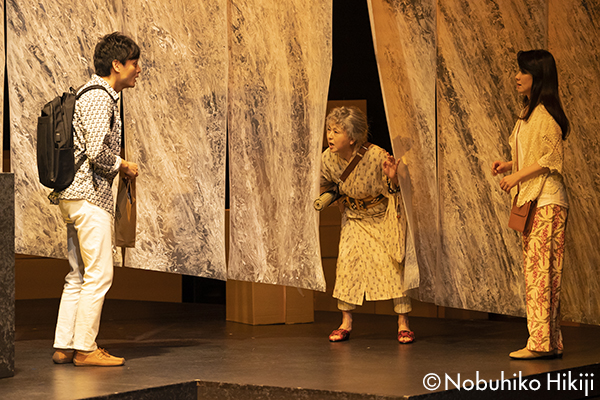
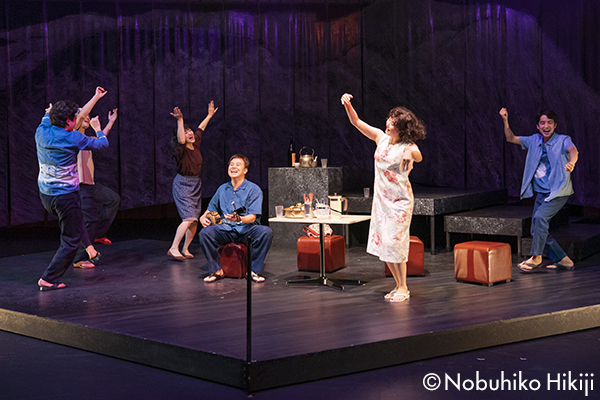
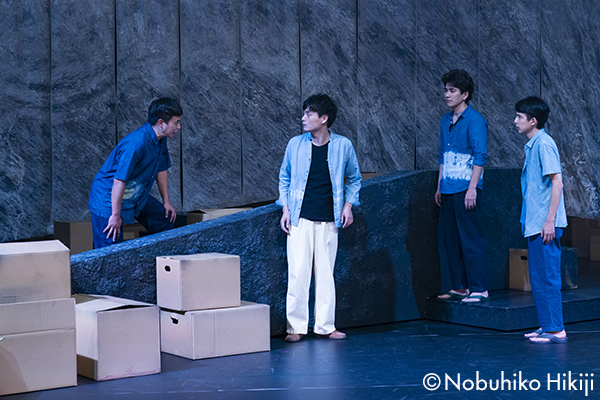
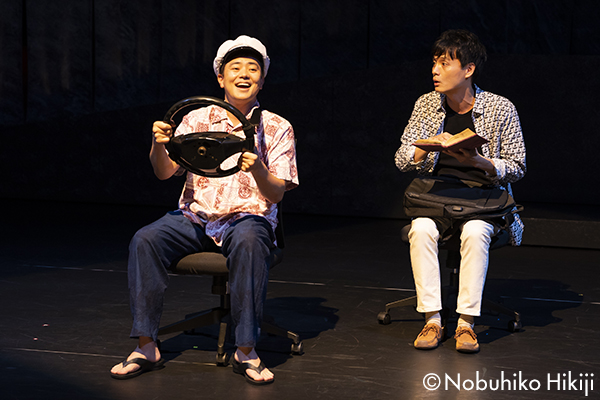
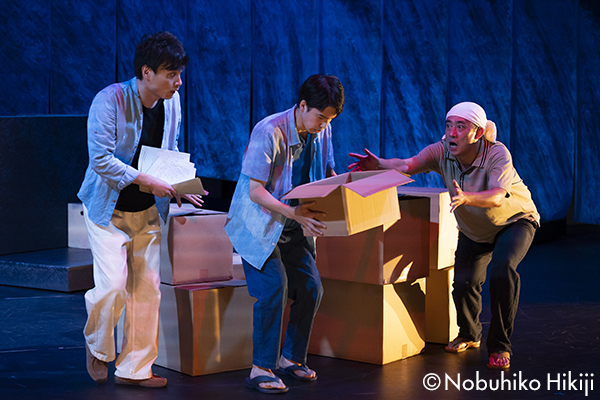
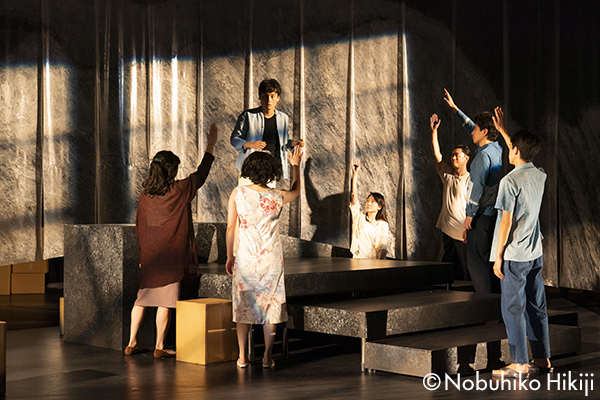
Backyard in RyCom (Produced by KAAT Kanagawa Arts Theatre)
(Nov. 30 – Dec. 4, 2022 at KAAT Kanagawa Arts Theatre, Medium Studio
Photo: Nobuhiko Hikiji
Data
:
Premiere: 2022
Backyard in RyCom

Born in 1989 in Okinawa City. Graduated from Okinawa International University. In 2013, he formed the theater group Choko-dorobo (Chocolate Thief) and wrote and directed the group’s plays. He specializes in conversational dramas using the language of Okinawan youth, and stages original scripts centered on comedy and mystery. He is also active as a theater unit Tamadorobo with Ryukyu dancer Takumi Tamaki. In 2018, he won the Okinawa Prefectural Governor’s Prize in the scenario and drama category of the 14th Okinawa Literature Awards for Folklore. In 2021, he wrote the script for the NHK-FM theater Fushigi no Kuni no Haisai Shokudo (Haisai Shokudo in Wonderland) and won the 31st Audio Drama Encouragement Prize. His play Backyard in RyCom won the Excellent Play Award in the 30th Yomiuri Theater Awards, as well as the 26th Tsuruya Nanboku Drama Award and was selected as a finalist for the 67th Kishida Kunio Drama Award.
Choko-dorobo






Backyard in RyCom (Produced by KAAT Kanagawa Arts Theatre)
(Nov. 30 – Dec. 4, 2022 at KAAT Kanagawa Arts Theatre, Medium Studio
Photo: Nobuhiko Hikiji
Data
:
Premiere: 2022
The setting is Yokohama in 2022. Asano, a magazine reporter, was planning to return to Okinawa, where the family home of his wife, Chika is located, in order to attend the funeral of his grandfather-in-law. His boss at the magazine, Fujii, introduces Asano to Irei, a woman from Okinawa who runs a bakery in Yokohama.
Irei shows him an old photo of a person who looks exactly like Asano. That person is Ire’s grandfather, who left a memoir of murders that had occurred in Okinawa. Fujii was planning a special feature in the magazine for the 50th anniversary of the return of Okinawa to Japan following the period of U.S. occupation after WWII, and he asked Asano to do research for an article on the incident while he was there for the funeral.
The scene shifts to Okinawa. On the way to Futenma by taxi, Asano listens as the driver talks about a shopping center called “Rycom” (*3) that was been built on the site of what had been a golf course of the U.S. military, and the story seems somehow prophetic to his ears.
The scene is now Chika’s parents’ house. Asano shows Chika, who had returned to the Okinawa home with their daughter earlier, the photo that Ire had shown him. Chika realizes that it is a photograph of her grandfather, Kanji Sakumoto. Sakumoto was a suspect in the case that Asano was going to investigate. Chika asks Kaneshiro, a medium who can talk to the dead, to find out the truth from her grandfather.
The scene shifts to the bakery in Yokohama. Fujii receives from Ire the court documents left by her grandfather of the case involving the death and wounding of American soldiers. When he opens the cardboard box, he hears an outflow of voices speaking English.
The scene is Kaneshiro’s house. The (deceased) 29-year-old Sakumoto summoned by the medium Kaneshiro begins to tell the story of the trial.
In 1964, the day before the incident, the scene is a noodle restaurant in Okinawa. Kanji Sakumoto, who runs a photo studio, and his employee Taira, Kanji’s brother Takenobu, who runs a taxi company, and Yoshikazu, a taxi driver and Kanji’s friend, his lover Mamiko, and the restaurant’s owner Taeko are all drinking together. The next day, Takenobu will be able to use the U.S. military golf course of which he has become a member, and everyone is excited about this.
It is now the day of the incident. On a cliff overlooking the sea of Itoman. Yoshikazu proposes to Mamiko, saying that he wants to start a family again from this place where her family had jumped into the sea to die rather than being captured by the Americans during the battle of Okinawa.
The scene shifts to the trial, and Mamiko’s testimony. Yoshikazu’s words at Itoman are interpreted as resentment against American soldiers.
At an oden shop. There are complaints about Takenobu not being able to use the golf course in the end because he was Uchinanchu (Okinawan native), but they still enjoy conversing as they drink. Taira, who left the store first, is attacked by American soldiers and Sakumoto and Yoshikazu go to help him.
At the trial. Taeko’s testimony. Yoshikazu’s words in the store are interpreted as evidence of his intent to take revenge on American soldiers.
At an oden shop. When Sakumoto returns, he is about to leave the store with a golf club in his hand, but Takenobu comes and stops him. Sakumoto releases the club and takes the sanshin (Okinawan traditional three-stringed instrument) and leaves.
At the trial. Takenobu’s testimony. Sakumoto’s words and actions are interpreted as murderous intent towards American soldiers.
The scene shifts to the year 2022. Asano and Fujii are talking on the phone. Apparently, Fujii has amorous intents toward Irei. Fujii urges that the article about the 1964 incident be written from the standpoint of the oppressed Okinawans.
Jury deliberations. Sakumoto pushes Asano to play the role of a juror, telling him to agree to the guilty charge, because no matter what they do, the future will not change.
At Chika’s parents’ house. The content of Asano’s manuscript has somehow been arbitrarily changed. Takenobu and Taira bring in a large number of cardboard boxes stolen from the base. But chaos erupts when it is found they contained nuclear weapons and poison gas.
Mamiko’s room in a house of prostitution. It seems that Mamiko is selling herself as a prostitute to American soldiers. When Asano asks if he can interview her, she says that she has broken up with Yoshikazu, because everyone is just trying to do something to make their own lives better.
At Irei’s bakery in Yokohama. Fujii is greeted by a strange man and pressured to make a “Ryukyu Disposition” (*4). The man says, “The Ryukyuans are Japanese, aren’t they?” and then, becoming a Japanese soldier, he heads off to the battlefield.
The scene shifts to a “gama” (caves in the southern area of Okinawa Island used for defense or as military hospitals during the battle of Okinawa) (*5) during World War II. Fujii, who came with Japanese soldiers, is told to drive out the Uchinanchu (native Okinawans) who are taking refuge in the gama. He is told that it is because everything has been decided.
Yokohama. Irei tells Fujii that General MacArthur (*6) wants to seize land and facilities for the (U.S.) occupation forces. She adds that [MacArthur says] it will surely be only temporary, so if it is a problem, they can set up a base in Okinawa.
Japanese soldiers become riot police and tell Fujii that they will remove those who are holding a protest sit-in opposing the landfill construction at Henoko [to expand the U.S. base area in the bay]. The riot police officer was Yoshikazu. Fujii and Irei get into a taxi driven by Yoshikazu.
Irei says, “We are all in this manuscript, and Fujii has been added in along the way.
Kaneshiro’s house. [The deceased] Sakumoto asks [the medium] Kaneshiro to summon his dead brother because he wants to talk to him. They go to Rycom, where data on the deceased is archived, to find his brother’s data.
Asano gets into the taxi of the driver he first encountered earlier [on his arrival in Okinawa]. The driver takes Asano to the sea and says that eventually this place will no longer be the sea. Okinawa is Japan’s backyard, and he says all problems happen in the backyard. Asano receives a call from Chika. Their daughter has gone missing in Rycom. The driver tells Asano that he knows what’s going to happen on the island, but that nothing can be changed.
Sakumoto opens a cardboard box in the backyard of Rycom and searches for his brother’s data. There, Taira and Yoshikazu join them, carrying cardboard boxes, and then Asano, Chika, and Fujii also arrive.
Taira says that as a rule of Okinawan stories, either their daughter or Irei must disappear. He says that it has been repeated time after time in Okinawa that someone important to someone disappears for no reason, but that enables Okinawans to go on living with as little suffering as possible.
Fujii and Chika go looking for them. To Asano, who is exhausted, Taira says that what you are writing is a story that pays the cost of peace by making many small sacrifices, and that he must continue to write it as such.
When the four of them, Sakumoto, Taira, Yoshikazu, and Asano, line up, the camera’s shutter is pressed and the flash flashes.
*1 Okinawa returned to Japan by the U.S. (Okinawa reversion)
After World War II, Okinawa was governed by the United States for a long time but was eventually returned to Japan on May 15, 1972.
*2 Murder of a U.S. soldier
On August 16, 1964, during the American occupation, American soldiers and four Okinawan youths (two of them from Tokunoshima in Kagoshima Prefecture) fought a brawl around the restaurant district of Futenma, Ginowan City, resulting in the death of one American soldier and serious injury of another. The four young Okinawans were charged with manslaughter by a U.S. civil court, which was reviewed by an American-majority jury. Although Okinawan jury member Chihiro Isa persuaded them to acquit them of manslaughter, three of them were sentenced to three years in prison for inflicting wounds.
*3 Rycom
Rycom stands for “Ryukyu Command Headquarters” that was once located in the central part of the main island of Okinawa. Today, Rycom remains as a place name, and in 2015, a huge shopping center “AEON MALL Okinawa Rycom” (commonly known as Rycom) opened on the site of the former Awase Golf Course restricted to use by the US military.
*4 Ryukyu Disposition
In a narrow sense, in 1879, the Meiji government of Japan abolished the Ryukyu Domain, which had inherited the former Ryukyu Kingdom, expelled the king from Shuri Castle, and established Okinawa Prefecture. As a result, the Ryukyu Kingdom fell and became part of Japan.
*5 Gama
There are many natural caves in Okinawa. These were used in various ways, and during World War II, they were used as air-raid shelters.
*6 MacArthur
At the end of World War II, the General Headquarters of the Supreme Commander of the Allied Powers implemented an occupation policy in Japan. This was called GHQ (abbreviation of General Headquarters) in Japan or the Occupation forces. General Douglas MacArthur was the Supreme Commander of the Allied Powers.
Related Tags